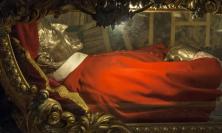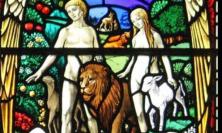Continuing his exploration of the relationship between science and theology, Dr Michael Fuller of the Theological Institute of the Scottish Episcopal Church unfolds some of the myths about historical points of alleged contention between the two disciplines. Were Columbus, Galileo and Darwin really swimming against the intellectual current of their times, or is there more to their stories than meets the eye?
In the first article of this series, we looked a little at the ways in which science and theology can inter-relate, and noted that that they need not be antagonistic, despite the way in which they are so often portrayed to be so. We shall now focus on some of the roots of the perceived antagonism between the two.
I’d like to begin with a story, which I suspect represents a version of history that many educated people in Britain today would hold to be true. It goes like this. Human beings have always sought explanations for the phenomena they observe in the world around them. In the past, inexplicable phenomena were put down to the action of God. In the West, this led ultimately to the emergence of a powerful Church, which assumed for itself authority to interpret the world. It was – or at least it became – reactionary and oppressive, and it stifled any attempts to explain things that were not in tune with its ideas. Eventually, though, a series of pioneers insisted that the world was not as the Church portrayed it to be, and demonstrated that they were correct and that it was wrong; and, through their efforts, a new way of looking at the world has emerged. This is the modern, scientific way of looking at the natural world. Such pioneers included: Christopher Columbus, who defied the ecclesiastical wisdom of the day which insisted the earth was flat, and demonstrated instead that it was a globe; Galileo Galilei, who similarly defied the wisdom of his day that insisted the earth was at the centre of the solar system, and placed the sun there instead; Charles Darwin, who put forward the idea that the various living species we see around us today evolved slowly over millennia, rather than being created individually by God; and Sigmund Freud, who showed that even such complex human experiences as emotions could be ascribed to physiological causes rather than being attributable to the outworkings of some ‘divine spark’ placed within us by God. The upshot of such pioneering work (and that of many other scientists and thinkers) was a new way of looking at things, which sees our environment, and even ourselves, as acting not always in accordance with the will of God, but rather as a consequence of laws; and these laws can be deduced and tested through the scientific method.
It transpires that an examination of this narrative proves it to be not only simplistic, but positively misleading. Take the case of Galileo. His story is a complex one, which takes us back to a world very different to our own. Galileo was not the first person to suggest that the sun was at the centre of the solar system: others had done this, not least Copernicus more than half a century earlier, but they had simply proposed this as a useful hypothetical device which made calculations easier, not declared that it was literally true that this was how the solar system was. For many years, Galileo’s work was well received by scholars of various religious orders, who feted his ideas. However, he landed himself in trouble with some undiplomatic writing in which he placed views known to be held by the then Pope into the mouth of a character called Simplicio. This led to his being charged with disobeying a church instruction to teach his ideas as calculating aids rather than as fact. His initial prison sentence was immediately commuted to house arrest under the guardianship of one of the Cardinals who was present at his hearing, and before long he was allowed to return home, where he continued his research and writing whilst notionally under house arrest.
To understand what was going on in the Galileo affair, it is necessary not only to comprehend the etiquette of the day, which could happily differentiate between holding something to be true and merely teaching it as a useful theory, but also to have some idea of the world-view of Galileo’s contemporaries. They were the inheritors of the so-called ‘mediaeval synthesis’, which has been described as ‘the whole organisation of their theology, science, and history into a single, complex, harmonious mental Model of the Universe.’ The mediaeval synthesis finds perhaps its greatest expression in Dante’s great poem, The Divine Comedy, in which, as you’ll recall, Dante first descends through the circles of hell, envisaged as a great funnel-shaped pit under the earth, before ascending the tiers of Mount Purgatory and finally moving through the crystalline heavenly spheres around the earth. It’s a remarkable model. Where, though, did it come from, and why was it so firmly believed?
Our mediaeval ancestors, like most of us, liked to have things neatly organised. Their system was derived largely from the writings of Aristotle, who was held to be the greatest of the ancient philosophers, defective only in his theological understanding (inevitably, since he was a pre-Christian thinker): his writings therefore needed to be supplemented by the Bible in this area in order to make them omnicompetent. The Aristotelian system attained such an internal coherence that it became impossible to challenge one part of it without challenging the whole.
We need to realise, too, that in mounting any such challenge it was expected that written sources, the older and more distinguished the better, would be cited to support the alternative view. The writings of the ancient authorities – most expressly the biblical writings, but also those of secular philosophers, historians and ‘scientists’ – were held in such high regard simply because they had lasted as repositories of truth for centuries. This attitude is difficult to conceive in our own age, which has come to expect knowledge to be constantly evolving and changing. In Galileo’s time, when resolving problems in theology, philosophy or science, it was very largely a question of amassing as much information from ancient authorities as possible in support of an argument. It was in these texts that truth was deemed to be found: at least, a considerable burden of proof lay with anyone who thought otherwise. For Galileo, this entire approach was anathema. He relied instead on the evidence of the observations he had made.
However, for Galileo’s contemporaries it simply wasn’t enough to draw attention to empirical observations in presenting an alternative to established wisdom. This was because they knew, as we do, that our senses are subjective, and that they can be fooled. What one person experiences as spicy food may to another taste fairly bland, for example; and, in a familiar optical illusion, parallel lines can be made to look crooked with cross-hatching. To his contemporaries, Galileo’s use of a telescope simply introduced another means by which their senses might be deceived. And by their standards, of course, they were quite right: Galileo had not supplied them with good enough evidence to believe him. It is absolute nonsense to describe Galileo’s contemporaries as in some way intellectually primitive, or as irrational. On the contrary, by the criteria of their day they were being extremely rational, and that’s why they didn’t believe him!
What was going on here was a revolution, but it wasn’t just a revolution of the way in which people saw the world: it was a revolution of the way in which people thought about knowledge, and proof. We sympathise with Galileo, because we are taught to think as he did: that empirical evidence – evidence gleaned through our senses, through making observations – is good evidence, which establishes points as conclusively as they can be established. His contemporaries, however, did not accord empirical evidence the same status. Quite simply, they thought differently; and we cannot and must not expect them to think like us. To do so is to be guilty of chronic historical provincialism. The past is, indeed, a foreign country; and they not only do things differently there, they think about things differently there, too.
When we move forwards to Darwin’s day, we find political and social factors equally important in the ways in which his contemporaries dealt with his ideas. First, though, it is interesting to observe where those ideas came from. Darwin used many sources in formulating his ideas, but three were perhaps of special significance. First, he drew on his own observations of the natural world, and on those of associates (Darwin maintained a wide correspondence with people from all over the world, who sent specimens to him). Most famously, there were the finches that Darwin observed on the Galapagos islands: birds that were very similar in many ways, but had adapted their shapes on each island to suit slightly different ways of living that were appropriate for each. Divergence of shape from a common ancestor over a lengthy period of time offers a very neat explanation of this observation.
Secondly, Darwin drew heavily on Thomas Malthus’s Essay on the Principle of Population. Malthus calculated that if humankind bred without any restraints, the population of the world would double in just 25 years, and before long the planet would be completely overrun. But the human race does not propagate so rapidly, and the reasons for this are that humans struggle for the available resources, and are prone to disease, famine, war and other predation. Malthus’s bleak conclusion was that the weak in society will inevitably die as they are left behind in the struggle for life. Darwin’s genius was the realisation that this was not a random process, but that some individuals survive in preference to others, because they possess characteristics that give them a particular advantage – longer legs, say, so that they can run faster and hence escape predators more easily. This means that those individuals that survive long enough to breed will pass on to their descendents precisely the sort of features that equip them to survive well in the ecological niche they occupy.
Third, Darwin drew on the burgeoning science of geology. Geologists conjectured that the complex formations of rocks which we observe around us were generated by the same processes which can be observed taking place today: the eruption of volcanoes, the deposition of sediments in the seas, and so on. Why was this important for Darwin? Quite simply, because it suggested that the earth was very, very old; and this meant that a timescale existed which allowed for tiny, random variations in plants and animals to accumulate through many generations, leading to the rich varieties of flora and fauna which we observe in the world around us.
Darwin’s work, then, was a superb synthesis of the knowledge of his time. T. H. Huxley, ‘Darwin’s bulldog’, who used evolutionary theory as a means of attacking the Church in his day, doubtless summarised the reactions of many to Darwin’s ideas when he said: ‘How incredibly stupid not to have thought of that!’
Darwin himself refused to draw anti-religious significance from his work. As a young man he had been a candidate for ordained ministry, albeit not a particularly enthusiastic one. In later life his faith was deeply shaken by the death of a greatly-loved daughter at the age of ten: even so, he abjured the label ‘atheist’, and stated that ‘agnostic would be the most accurate description of my state of mind’. Darwin wrote to one correspondent that he thought it perfectly possible to be ‘an ardent Theist & an evolutionist’, a view which many today continue to affirm. However, there were others in Darwin’s time who seized upon his ideas in order to further their own particular agendas. Noteworthy among these was the afore-mentioned T. H. Huxley. At this time in England, science was largely the preserve of a leisured elite: gentleman amateurs, and clergy. Moreover, the Church of England exercised a large amount of control within the Universities, a large proportion of the dons at these being ordained. Huxley was determined to wrest control of the sciences from such people, and establish science as a profession in its own right. A classic skirmish in this struggle came in a debate in 1860, which pitted (amongst others) Huxley against Samuel Wilberforce, the Bishop of Oxford. It’s still broadcast now as a striking occasion on which enlightened scientific thinking triumphed over clerical obscurantism – despite the fact that historians have demonstrated this understanding of the debate to be entirely spurious: what we would now call spin, concocted by Huxley and his supporters.
It’s interesting to note that the myth that Columbus overturned the received notion of a flat earth appeared at this time. The popular version of this story is in fact completely untrue: no-one in Columbus’s day seriously thought the earth was flat. The myth that they did appears to have originated in a book by the nineteenth-century American writer, Washington Irving, who simply invented a Church Council at Salamanca at which the ecclesiastical authorities told Columbus the earth was flat. It makes for dramatic reading, but it is entirely fictitious. The notion of Galileo as a heroic figure battling against the dim-witted Churchmen of his day also emerged at this time: as we have seen, more recent research has demonstrated just how wrong an idea this was. All these cases, though, were advanced by those with secularising agendas, in order to present the Church as inherently anti-progressive and anti-scientific.
In conclusion, we can see that the widely-accepted story of how Western society has become more enlightened, embracing ‘scientific’ perspectives and turning away from ‘religious’ ones as it does so, is actually rather crude, and is capable of being unpacked in ways that reveal subtleties and nuances we might not originally have expected to be there. And this brings me to one final point, which concerns the role of stories, of narratives, in constructing meaning for us. Facts, be they the data we accrue from scientific experiments or the information we glean from the study of history, don’t in and of themselves ‘mean’ anything: rather, they take on meaning through their being located in particular narratives. The post-enlightenment narrative about the inexorable rise of science is one such narrative; but there is nothing that especially privileges it, and if we are prepared to go beneath the surface of the account it presents, we discover that there are in fact other narratives which can do equal, if not better, justice to much of the historical data before us.
Dr Michael Fuller studied Organic Chemistry at Oxford and Theology at Cambridge before being ordained into the Anglican Church. He worked in parishes in England and Scotland before taking up his present post at The Theological Institute of the Scottish Episcopal Church. He is Honorary Fellow of New College, University of Edinburgh and is the author of Atoms and Icons (Mowbray, 1995).
This article is the second in a three-part series which originated in talks delivered at the Lauriston Jesuit Centre, Edinburgh, in May 2010.
![]() Science and Theology: An Introduction
Science and Theology: An Introduction
![]() Science and Theology: Consonances
Science and Theology: Consonances






